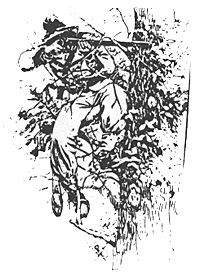 Due to a recent personal interest in the American Civil War, I have been ransacking the Library at the University of Illinois for any and all books on the subject that I have not read yet. In the course of this - I have been running down information on odds and ends - and ran across some comments on the relationship between Grant, Sheridan, and Wade. What I read boils down to the fact that after the summer of 1864 Grant, while he thought Meade was an excellent fellow and a good general, never the less consistently passed him over for various commands and gave those jobs to Phil Sheridan. The reason for this was that Wade lacked that "killer" instinct that Sheridan had of going for the throat, and hurling every last man into action, and pressing on to the point where nothing but total victory satisfied Sheridan. For the actions in the Valley in 64-65, at Five Forks, and on the road to Appomattox Court House - Sheridan was the man for the job.
Due to a recent personal interest in the American Civil War, I have been ransacking the Library at the University of Illinois for any and all books on the subject that I have not read yet. In the course of this - I have been running down information on odds and ends - and ran across some comments on the relationship between Grant, Sheridan, and Wade. What I read boils down to the fact that after the summer of 1864 Grant, while he thought Meade was an excellent fellow and a good general, never the less consistently passed him over for various commands and gave those jobs to Phil Sheridan. The reason for this was that Wade lacked that "killer" instinct that Sheridan had of going for the throat, and hurling every last man into action, and pressing on to the point where nothing but total victory satisfied Sheridan. For the actions in the Valley in 64-65, at Five Forks, and on the road to Appomattox Court House - Sheridan was the man for the job.
Looking back at the many generals I have faced across the gaming tables of my life, and the players who have been in games that I have run - it would seem that the "killer" general is very much a part of our hobby. How many times have you seen a player hurl all of his forces into the fray, including the sad remains of the 234th Fusiliers/Tennessee/whatever - which - down to 10% of its starting strength - walks willingly forward to certain death and destruction. Surrounded - down to his last round of ammo when asked if he is willing to call the game our commander declares 'NEVER' and proceeds to fight till the last man is down. He/she is there - and we have all either seen him, or more likely played out that role.
A quick checklist of Civil War generals with the killer instinct reveals damn few - Sheridan, Custer, Forrest, and Jackson. A further study of the numbers reveals the reason why there are so few. Generals with the killer instinct motivate their troops by being in the forefront of the battle - not safely in the rear. Reading an account of the Battle of Five Forks - I was struck by a comment of a Pennsylvania Cavalry Regiment which reported that they had 48 carbines on the line of battle - and that this number was made up by using officer's servants as horse holders. This same history talks about the effect that Sheridan had on his command as he moved up and down the field of action - his position marked by his command flag - always in front - never in the rear. A check of Jackson, Forrest, or Custer's actions will show the same concept, they lead.
The reason why there are so few commanders with that killer instinct is that most of them were killed or wounded before they reached the command level - and that those who survived were dared lucky - if you go down through the pages of military history and look at the numbers of killer generals, I think you will find this to be the case. Killer generals die quicker than cautious generals - hence armies tend to have a lot more of them around.
Since there is no long term punishment for being a killer general on our tabletop battlefield, and since most rules do not require the commander to share the fate of his men - we tend to find a lot more of them. Sheridan could move the 48 men forward into battle because he was there leading them - we just write an order and those two or three figures go willingly forward - while our command figure hides where it can't be shot at. If the battle is lost - so what - I'll send them off again next time.
I'm not sure if there is a solution to this problem - or perhaps if one is even needed. It is something_ to think about, and which perhaps those rules writers out there need to address. Well, the grand battery is threatening my flank, and my cavalry division is down to regiments of two or three stands each - it's time to send them forward on a do or die charge - so forward my children.... and I'll remain right here!
Back to MWAN # 23 Table of Contents
Back to MWAN List of Issues
Back to MagWeb Magazine List
© Copyright 1986 Hal Thinglum
This article appears in MagWeb.com (Magazine Web) on the Internet World Wide Web.
Other articles from military history and related magazines are available at http://www.magweb.com